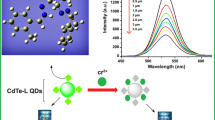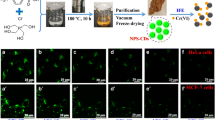Abstract
The authors describe a two-step strategy for in-situ dispersive solid phase extraction (is-dSPE) of Cr(VI) ion (chromate) prior to its determination by using copper nanoclusters capped with 4,6-diamino-2-mercaptopyrimidine (DAMP-CuNCs) as a fluorescent probe. By emulating the formation of layered double hydroxides and taking advantage of their compositions, the extraction of chromate is accomplished by rapidly dispersing a suspension of mixed hydroxides of Mg2+ and Al3+ into the sample solution. After enrichment, chromate is directly quantified through selective quenching of the fluorescence of DAMP-CuNCs. This results from an inner filter effect caused by chromate only, while other anions have no effect. Under optimized conditions, the method has a linear response in the 1–7 μM chromate concentration range, and the lower limit of detection is 0.31 μM. The is-dSPE has improved detection sensitivity and has provided a highly selective response. It was successfully applied to the determination of chromate in (spiked) water samples, and the results agreed well with data obtained by ICP-OES.

Schematic of a two-step strategy for is-dSPE of Cr(VI) ion prior to its determination by using DAMP-CuNCs.





Similar content being viewed by others
References
Sriratana S, Scamehorn JF, Chavadej S, Saiwan C, Haller KJ, Christian SD, Tucker EE (1996) Use of polyelectrolyte-enhanced ultrafiltration to remove chromate from water. Sep Sci Technol 31:2493–2504
Wang C, Shu S, Yao Y, Song Q (2015) A fluorescent biosensor of lysozyme-stabilized copper nanoclusters for the selective detection of glucose. RSC Adv 5:101599–101606
Wang L, Shi F, Li Y, Su X (2016) An ultra-sensitive and label-free fluorescent probe for trypsin and inhibitor based on DNA hosted Cu nanoclusters. Sensors Actuators B Chem 222:945–951
Cao H, Chen Z, Huang Y (2015) Copper nanocluster coupling europium as an off-to-on fluorescence probe for the determination of phosphate ion in water samples. Talanta 143:450–456
Cao H, Chen Z, Zheng H, Huang Y (2014) Copper nanoclusters as a highly sensitive and selective fluorescence sensor for ferric ions in serum and living cells by imaging. Biosens Bioelectron 62:189–195
Chen Z, Lu D, Zhang G, Yang J, Dong C, Shuang S (2014) Glutathione capped silver nanoclusters-based fluorescent probe for highly sensitive detection of Fe3+. Sensors Actuators B Chem 202:631–637
Das NK, Ghosh S, Priya A, Datta S, Mukherjee S (2015) Luminescent copper nanoclusters as a specific cell-imaging probe and a selective metal ion sensor. J Phys Chem C 119:24657–24664
Feng J, Ju Y, Liu J, Zhang H, Chen X (2015) Polyethyleneimine-templated copper nanoclusters via ascorbic acid reduction approach as ferric ion sensor. Anal Chim Acta 854:153–160
Liu ZC, Qi JW, Hu C, Zhang L, Song W, Liang RP, Qiu JD (2015) Cu nanoclusters-based ratiometric fluorescence probe for ratiometric and visualization detection of copper ions. Anal Chim Acta 895:95–103
Ruiyi L, Huiying W, Xiaoyan Z, Xiaoqing L, Xiulan S, Li Z (2016) D-Penicillamine and bovine serum albumin co-stabilized copper nanoclusters with remarkably enhanced fluorescence intensity and photostability for ultrasensitive detection of Ag+. New J Chem 40:732–739
Xiaoqing L, Li R, Li Z, Sun X, Zhouping W, Liu J (2015) Fast synthesis of copper nanoclusters through the use of hydrogen peroxide additive and their application for the fluorescence detection of Hg2+ in water samples. New J Chem 39:5240–5248
Soomro RA, Nafady A, Sirajuddin MN, Sherazi TH, Kalwar NH (2014) L-cysteine protected copper nanoparticles as colorimetric sensor for mercuric ions. Talanta 130:415–422
Yang X, Feng Y, Zhu S, Luo Y, Zhuo Y, Dou Y (2014) One-step synthesis and applications of fluorescent Cu nanoclusters stabilized by L-cysteine in aqueous solution. Anal Chim Acta 847:49–54
Luo Y, Miao H, Yang X (2015) Glutathione-stabilized Cu nanoclusters as fluorescent probes for sensing pH and vitamin B1. Talanta 144:488–495
Zhou T, Yao Q, Zhao T, Chen X (2015) One-pot synthesis of fluorescent DHLA-stabilized Cu nanoclusters for the determination of H2O2. Talanta 141:80–85
Bhamore JR, Jha S, Mungara AK, Singhal RK, Sonkeshariya D, Kailasa SK (2016) One-step green synthetic approach for the preparation of multicolor emitting copper nanoclusters and their applications in chemical species sensing and bioimaging. Biosens Bioelectron 80:243–248
Zhu HW, Dai WX, Yu XD, Xu JJ, Chen HY (2015) Polythymine stabilized copper nanoclusters as a fluorescence probe for melamine sensing. Talanta 144:642–647
Zhao XJ, Huang CZ (2014) Water-soluble luminescent copper nanoclusters reduced and protected by histidine for sensing of guanosine 5′-triphosphate. New J Chem 38:3673–3677
Cui M, Song G, Wang C, Song Q (2015) Synthesis of cysteine-functionalized water-soluble luminescent copper nanoclusters and their application to the determination of chromium(VI). Microchim Acta 182:1371–1377
Kong L, Chu X, Liu W, Yao Y, Zhu P, Ling X (2016) Glutathione-directed synthesis of Cr(VI)- and temperature-responsive fluorescent copper nanoclusters and their applications in cellular imaging. New J Chem 40:4744–4750
Tang S, Zhang H, Lee HK (2016) Advances in sample extraction. Anal Chem 88:228–249
Abolghasemi MM, Yousefi V, Piryaei M (2015) Double-charged ionic liquid-functionalized layered double hydroxide nanomaterial as a new fiber coating for solid-phase microextraction of phenols. Microchim Acta 182:2155–2164
Sansuk S, Nanan S, Srijaranai S (2015) New eco-friendly extraction of anionic analytes based on formation of layered double hydroxides. Green Chem 17:3837–3843
Ravel B, Newville M (2005) ATHENA, ARTEMIS, HEPHAESTUS: data analysis for X-ray absorption spectroscopy using IFEFFIT. J Synchrotron Radiat 12:537–541
Acknowledgements
This research was financially supported by the Thailand Research Fund (RSA6080006), the Higher Education Research Promotion and National Research University Project of Thailand, Office of the Higher Education Commission, through the Advanced Functional Materials Cluster of Khon Kaen University, and the Center of Excellence for Innovation in Chemistry (PERCH-CIC), Office of the Higher Education Commission, Ministry of Education.
In remembrance of His Majesty King Bhumibol Adulyadej (1927-2016), for his life-time dedication to Thailand.
Author information
Authors and Affiliations
Corresponding author
Ethics declarations
The author(s) declare that they have no competing interests.
Electronic supplementary material
ESM 1
(DOC 4812 kb)
Rights and permissions
About this article
Cite this article
Khonkayan, K., Sansuk, S., Srijaranai, S. et al. New approach for detection of chromate ion by preconcentration with mixed metal hydroxide coupled with fluorescence sensing of copper nanoclusters. Microchim Acta 184, 2965–2974 (2017). https://doi.org/10.1007/s00604-017-2320-2
Received:
Accepted:
Published:
Issue Date:
DOI: https://doi.org/10.1007/s00604-017-2320-2




